Technology
Why returning Apple’s Vision Pro headset?
Published
7 months agoon
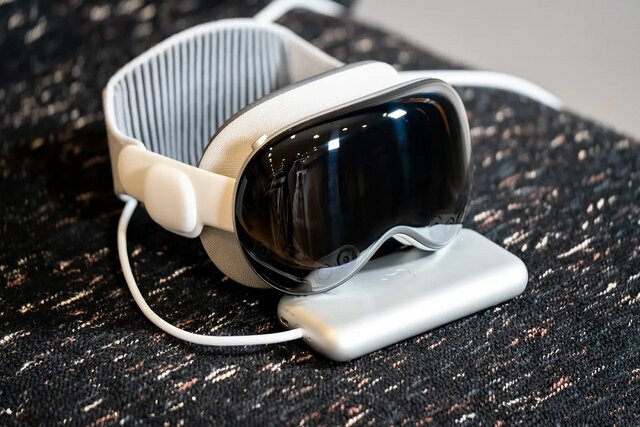

Almost 2 weeks have passed since the release of Apple’s Vision Pro headset, and the 14-day return window for early adopters is about to close. Returning or keeping the headset is a question that has occupied many minds. So why are people returning Apple’s Vision Pro headset?
Why returning Apple’s Vision Pro headset?
Apple’s Vision Pro headset was released to buyers two weeks ago, on February 2nd. Now, many early adopters are rushing to return the headset as we approach the close of Apple’s 14-day return window.
According to ZDNet, it is not clear what percentage of Vision Pro users return this headset, and Apple is not expected to release this figure. The company has reportedly sold 200,000 units of the Vision Pro, but reviews so far have been mixed. ZDNet has checked through Reddit to find the most common complaints from Vision Pro users, and we will address them below.
1. How to place Vision Pro on the face is troublesome
Many users complain about the problem of light entering the Vision Pro. There are complaints about getting headaches and users feeling like they are watching a movie with a hunting camera. The light that penetrates through the nose also spoils the experience of using this headset. These problems can often be enough to force users to return the device, even if the fix only requires a simple replacement of a part to block light from entering.


The part that needs to be replaced is shown in gray
Apple has different-sized pieces to block light, and if you want to return your Vision Pro because it feels uncomfortable on your face or light is leaking in from the edges, it might be helpful to take the device to an Apple Store and try out different sizes of the piece. be
2. Eye strain is real and there is no way around it
One might think that using eyes and fingers to navigate the digital world is intuitive and convenient, but that’s not always the case.
Eye tracking in Vision Pro can be tedious and cause eye pain and fatigue. Eye strain can be an issue that improves as the user’s body gets used to the device, but it’s a big reason some users consider returning the device.
3. The Vision Pro is too heavy for long-term use
The Vision Pro weighs between 21.2 and 22.9 ounces (601 and 609 grams). That’s a lot of weight to put on the face. For a better understanding, it should be said that a 12.9-inch iPad Pro weighs 24 ounces (680 grams) and three iPhone 15 Pro Max stacked on top of each other weighs 23.4 ounces (663 grams), and a five-digit banana cluster weighs 17.3 They weigh ounce (490 grams).


Some users make modifications with 3D printing machines to better distribute the weight. Others report that they can’t wear it while watching a movie.
Read More: Android 15 features: Everything you need to know
4. The technology doesn’t exist yet
Apple Vision Pro is undoubtedly a revolutionary device. The first computers were the same, but they took up an entire room or more. With today’s laptops, smartphones, and wearable technology, those days are a long way from now.
Fortunately for Apple, the Vision Pro doesn’t have as long a road ahead as the PC, but many of the complaints from users of the device are that the technology still isn’t good enough to justify keeping the device and not returning it.
Complaints about poor text rendering for smaller text, and lag during standard computing tasks are common, which is problematic for a device marketed for productivity and work.
5. The world of space computing is too lonely
I can imagine putting the Vision Pro on my face to watch a 3D movie or space video and momentarily being oblivious to the technology and saying to someone who doesn’t have it on their face: See that? And only to be met with a confused look.
Using Vision Pro can be a beautiful experience for the user, but it can also be a lonely experience.


Using this headset is like putting on a pair of headphones. When it turns on, you become isolated and alone. If we want to be optimistic about it, we should say that this will only be a short-term phenomenon, because over time, VR headsets will eventually be accepted as a part of clothing, and in people’s social environments you will learn how to physically interact with them. Communicate with each other Even when there is a barrier in the face, there will be more meaningful ways to connect with people in virtual reality. Entering FaceTime into Vision Pro is one way to get started.
6. Vision Pro is very expensive
We understand that Vision Pro is not marketed to Americans struggling to get their daily groceries. This headset was always intended for those early adopters willing to spend money on a major tech product like this and developers looking to invest in the platform.


But $3,500 for a VR headset without accessories is a lot of money, even for enthusiastic early adopters. As the hype for the Vision Pro dies down, many who shelled out more than $4,000 for it including accessories and tax are struggling to justify the cost.
7. “I just wanted to try it.”
Some owners of Apple’s headset have purchased the device only to return it later, just to get a chance to test it out and maybe post a selfie or two on social media with it.
Apple’s generous refund policy makes this possible. This company allows you to return any device within 14 days of purchase, as long as it is in its original condition and its packaging is intact.


You may like
-




How to hide a file or directory in Linux?
-




Everything we expect from the iPhone 16 unveiling ceremony
-

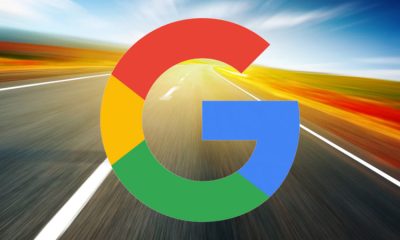


Google brand story; From a small startup to ruling the web world
-




The Icon of the Seas cruise ship, a city on water
-




Designed in California, copied in the Soviet Union; The story of the first Soviet chip
-

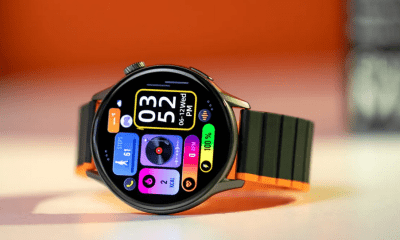


Xiaomi Glorimi M2 Max watch review; Alternative economic option for iPhone owners


fewDeterminer: An indefinite, but usually small, number of.
Determiner: Not many; a small (in comparison with another number stated or implied) but somewhat indefinite number of.
Determiner: Obscuring one to two okta (eighths) of the sky.
Determiner: (US?) Having a 10 percent chance of measurable precipitation (0.01 inch); used interchangeably with isolated.
Pronoun: Few people, few things.
How to hide a file or directory in Linux?
Most of us have files on our computer or laptop that we don’t want other people to see. If your system uses a Mac or Windows operating system, you can use various tools to hide different files and folders or even encrypt your favorite files to better protect your privacy. In this article, we will talk about how to hide a file or directory in Linux.
In Linux computers and laptops, like Windows and Mac, you can hide your favorite files and directories from the view of others both through the terminal of the operating system and by using some tools that are very easy to use. In the following, we will introduce some efficient methods to hide files and directories in Linux.
Hide files and directories through the terminal
The easiest way to hide various files and directories in Linux is to use the Linux terminal or the Linux graphical environment (GUI).
- Open a Linux terminal window by pressing Ctrl+Alt+T.
- In the terminal, type the following command:
Note: instead of sync.ffs_db, you must enter the name of the file you want and then type the file name again with a dot (.) at the beginning.

To hide the file through the graphical environment (GUI) of Linux, proceed as follows:
- First, right-click on the desired file and click on the Rename option.

- Put a dot (.) at the beginning of the file name.

- Open and close the file once to apply the changes and hide the file.
Hide files in an image
Although hiding the file and directory in Linux by changing the file name seems to be a simple and fast method, but equally, it becomes easy for people who are a little familiar with the Linux environment to access this file. Therefore, we suggest that you go for a better method.
Data encryption or steganography is a method of hiding information in a normal image file, which, like the first method, has almost simple steps, but unlike it, it really hides the files you want from anyone’s view, and you can even hide them after hiding them. Delete the original file in the image irretrievably. In the following, we will teach the steps to hide the file and directory in an image file using the Linux terminal.
- Open the Linux terminal and create a new folder (directory) using the following command.
Note: instead of newdir, enter your desired name for the new directory.
- Copy or move the image file (PNG or JPG) you want to use to hide your desired file into the new folder you created.
Important note: sometimes, depending on the size of the files or the number of files you want to hide in an image, you may need to use a large image so that you have enough space to store the files inside the image.
If you want to hide multiple files, it is better to compress them into one zip file. To compress files in Linux, you must first create a new folder.
- To create a new folder inside the folder you have already created, enter the following command in the Linux terminal:
Note: instead of tmp, you must type the name of the folder you created in the previous step and enter your desired name for the new folder instead of newdir.
In this tutorial, we created a main folder named Images, which contains an image named MainImage.png and a subfolder named FileToHide. This subfolder contains all the files we want to hide.
- To compress your files into a zip file, run the following command in the Linux terminal:
Note: The r- code in the above command includes all the subfolders in the specified folder in the compressed file. In this command, instead of secret.zip, replace the desired name; You should also enter the name of the folder where you have saved all the files you want to hide instead of FileToHide.

To hide the zipped file in your desired image, run the following command in the Linux terminal:
Note: In this command, MainImage.png is our main image file and secret.zip is the name of the zip file that contains all the files we want to hide. In fact, we redirected these two files to a new image file called secret.png. Be careful that the names of MainImage and secret (in both files with PNG and zip extensions) should be replaced with the names you want.
- After running this command, if you want to see a list of all the files in the folder, use the ls command. In this directory, you will see the file name of the new image you created.

- To access files hidden in an image file, use the following command to extract the zip file from within the image:
Note: replace secret.png with the name you chose for the image file containing the secret files .
- When you run the ls command , the root folder containing the files you zipped will be displayed.

- In this case, if you want to see the original files, enter the following command in the terminal:
Delete the original file after hiding it in the image
Sometimes you may want to delete the original version of the file after hiding the sample files you want in an image file. You can use the shred command to do this. This command replaces the file value with a specific value when the file is deleted. For example, we can set the file value to zero when deleting a file.
- For this purpose, after opening the Linux window, run the following command:
By default, these files are overwritten three times (meaning rewriting new information, without the ability to recover previous information). This amount is usually enough, but if you want to overwrite the file more often, you only need to enter the command as follows and replace N with the number of times you want the files to be overwritten.
In this command, the z-code replaces the value of the file with the value zero. Also, the remove- code removes files; Of course, this is done through the shred command itself, but without entering remove- in the shred command, the file removal operation will not be done completely.

What method do you use to hide your files in Linux? We will be happy if you share your experiences in this field with us and other Zomit users.
Technology
Everything we expect from the iPhone 16 unveiling ceremony
Published
13 hours agoon
09/09/2024

Verb: To cause, make (someone) (do something).
Verb: To suffice.
Verb: To be reasonable or acceptable.
Verb: To have (as an effect).
Verb: To fare, perform (well or poorly).
Verb: To have as one’s job.
Verb: To perform the tasks or actions associated with (something).
Verb: To travel in, to tour, to make a circuit of.
Verb: To treat in a certain way.
Verb: To work for or on, by way of caring for, looking after, preparing, cleaning, keeping in order, etc.
Verb: To act or behave in a certain manner; to conduct oneself.
Verb: To spend (time) in jail. (See also do time)
Verb: To impersonate or depict.
Verb: To copy or emulate the actions or behaviour that is associated with the person or thing mentioned.
Verb: To deal with for good and all; to finish up; to undo; to ruin; to do for.
Verb: To punish for a misdemeanor.
Verb: To cheat or swindle.
Verb: To convert into a certain form; especially, to translate.
Verb: To finish.
Verb: Used to form the present progressive of verbs.
Verb: To cash or to advance money for, as a bill or note.
Verb: To make or provide.
Verb: To injure (one’s own body part).
Verb: To take drugs.
Verb: To exist with a purpose or for a reason.
Verb: To drive a vehicle at a certain speed, especially in regard to a speed limit.
Noun: A party, celebration, social function; usually of moderate size and formality.
Noun: Something that can or should be done.
Noun: Something that has been done.
Noun: ado; bustle; stir; to-do; A period of confusion or argument.
Noun: A cheat; a swindler.
Noun: An act of swindle; a fraud or deception.
Noun: A homicide.
Noun: A syllable used in to represent the first and eighth tonic of a major scale.
Numeral: The cardinal number occurring after and before do one in a duodecimal system. Written 10, decimal value 12.
Everything we expect from the iPhone 16 unveiling ceremony
Now that Samsung and other giants have launched their new flagships, it’s Apple’s turn to shine.
Apple’s new press conference, which is related to the unveiling of the iPhone 16, will be held with the slogan It’s Glowtime; A slogan that clearly expresses Apple’s ambition to have a stronger presence in the mobile market.
The invitation to the It’s Glow time event, which was sent to the media on the 5th of September, has the Apple logo as always, but this time different colors have been mixed and the design of the poster reminds us a lot of the WWDC 2024 event poster; The same ceremony that was the birthday party of “Apple Intelligence”.
Its Glowtime poster indirectly hints at important news about artificial intelligence, but the main star of the event will undoubtedly be the iPhone 16, and at the top of it, the Pro Max model.
-
How to watch It’s Glowtime?
-
iPhone 16; leading actor
-
Apple Watch Series 10 or Apple Watch X?
-
Apple Watch Ultra 3 and new Apple Watch SE; The most expensive and cheapest Apple watches
-
Airpod 4; Apple’s different presence in the Togoshi headphone market
-
Possible surprise: iPad mini 7
-
other important events; From accessories to artificial intelligence and the new version of iOS
How to watch It’s Glowtime?
Apple has said that it will hold its new ceremony on September 19 at 20:30 Iran time. Apple events are always held on Tuesdays, but this time we will see the event on Monday.
It’s Glowtime will be broadcast on pre-recorded video, but Apple will also hold an in-person event for media at the Steve Jobs Amphitheater in Cupertino, California.
The unveiling ceremony of the iPhone 16 will be broadcast on YouTube and Apple’s official website. Zomit will also broadcast this event live.
iPhone 16; leading actor
The most important product of 2024 Apple is the iPhone 16. As the whistleblowers say, this year iPhone 16 will be available in four models, including the standard model, Plus, Pro, and Pro Max.
iPhone 16 and iPhone 16 Plus, like the iPhone 15 and iPhone 15 Plus, will have 6.1-inch and 6.7-inch screens, respectively. Meanwhile, the iPhone 16 Pro and iPhone 16 Pro Max are expected to use 6.3-inch and 6.9-inch displays, which are slightly larger than the iPhone 15 Pro and iPhone 15 Pro Max.
 Image attributed to iPhone 16 replica; Pay attention to changing the arrangement of camerasMajin Buu on X
Image attributed to iPhone 16 replica; Pay attention to changing the arrangement of camerasMajin Buu on X
One of the most important changes to the iPhone 16 will be the change in the arrangement of the rear cameras. This time, there is no news of a diagonal arrangement, and probably the design philosophy of the iPhone 10 will be revived once again so that the iPhone 16 and iPhone 16 Plus, like the Pro and Pro Max models, have the ability to record 3D video for playback on the Apple Vision Pro headset. The vertical arrangement of the cameras is considered a significant change.
Probably more iPhone cameras in the new generation will be equipped with a 48-megapixel sensor. Meanwhile, it is said that the periscopic lens of the iPhone 15 Pro Max will appear in the Pro model for the first time this year.
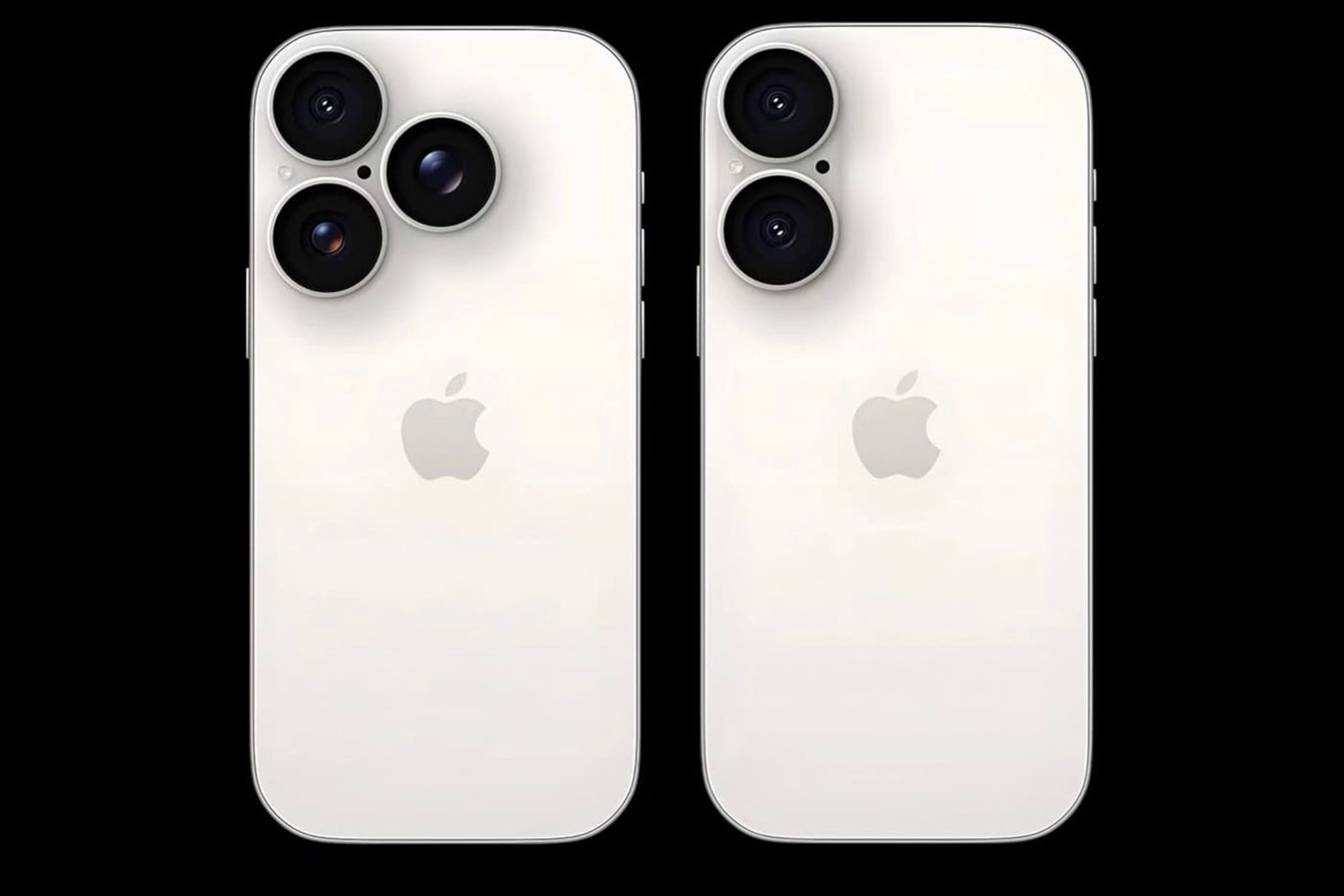 iPhone 16 next to iPhone 16 Pro; The image above is not an official
iPhone 16 next to iPhone 16 Pro; The image above is not an official
It is said that Apple is looking to use the A18 Pro processor in the iPhone 16 Pro and iPhone 16 Pro Max, and the iPhone 16 and iPhone 16 Plus will probably be equipped with the A18 processor with the same performance as the A17 Pro. We probably won’t see the phone overheating this year; Because Apple has been able to find a solution to the problem.
The Neural Processing Unit (NPU), which handles artificial intelligence processing, will be strengthened in the iPhone 16 series chips. Thanks to this unit, the new iPhones will handle the heavy processing of Apple Intelligence.
Another important change is the addition of the action button to all four phones so that iPhones can finally say goodbye to the mute slider. Maybe this year we will see a new button called the “capture button”. This button will be used to record photos and videos.
Apple Watch Series 10 or Apple Watch X?
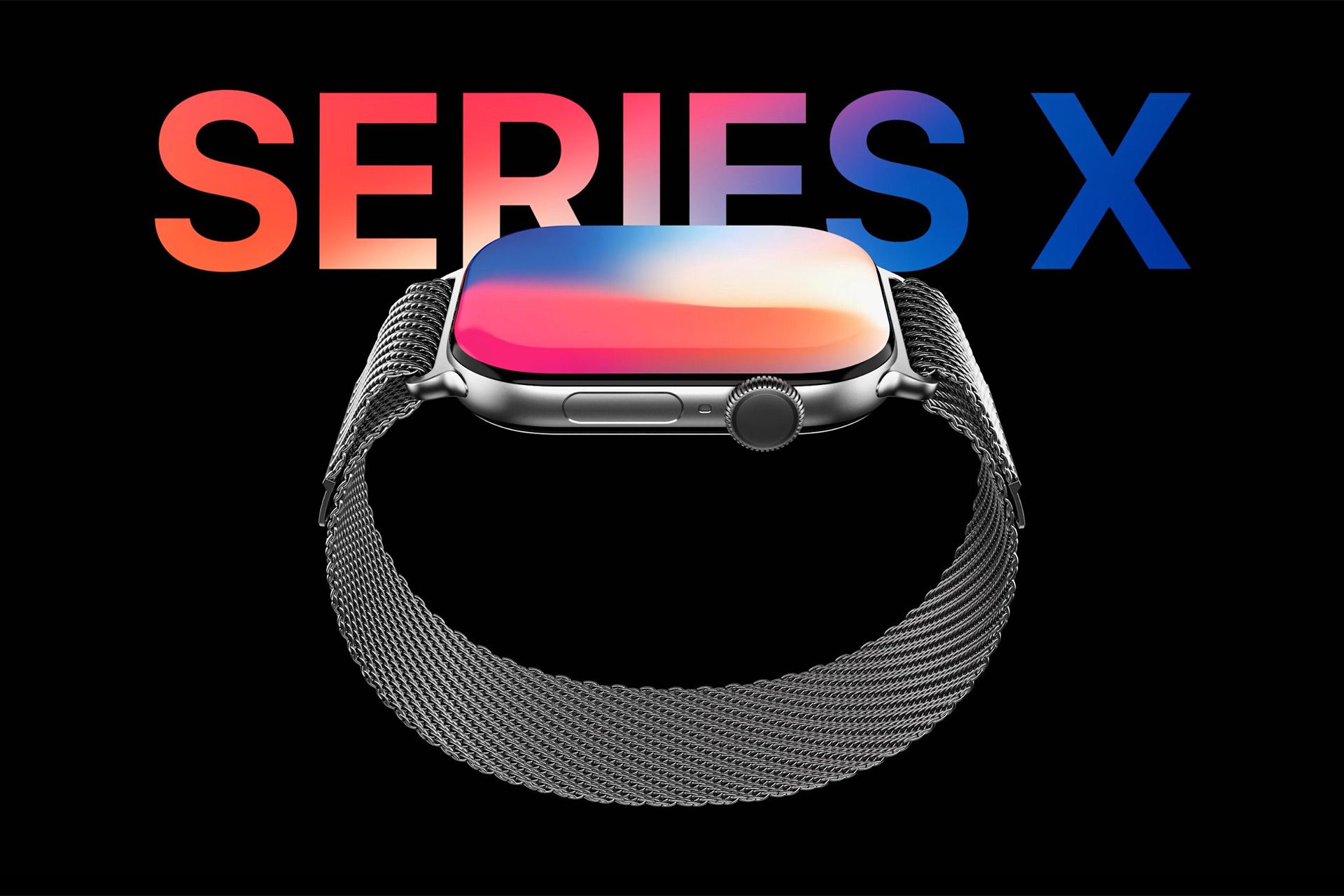 The image above is not official
The image above is not official
The unveiling of the iPhone 16 will not be the only important event of It’s Glowtime. Apple is celebrating the 10th anniversary of the Apple Watch this year, and it’s reasonable to assume that the company has big plans for its new watches.
It is said that the special model of the Apple Watch (possibly named Apple Watch X – read Apple Watch 10) will have a slimmer body than the current model, but its design is not going to change dramatically. Increasing the size of the screen will be one of the most important changes, and apparently, Apple wants to launch the Apple Watch 10 in two models.
According to the whistleblowers, the 45mm model will become the smallest Apple Watch 10 model, and the main model with a 49mm frame will be the same size as the Apple Watch Ultra.
Write Apple Watch X, read Apple Watch 10
Ming-Chi Kuo, who has a long history of revealing Apple information, says that the Apple Watch 10 will be equipped with a resin-coated copper (RCC) motherboard to reduce the thickness of the logic board and increase the durability of the watch against water penetration.
Mark German, a well-known Bloomberg whistleblower, previously said that Apple is looking to improve the strap connection system and wants to use a magnet system in the Apple Watch 10; However, the new reports of Germany have not mentioned such a feature. If such a system is implemented, none of the current Apple Watch bands will be compatible with the new model.
The Apple Watch 10 will have the ability to detect high blood pressure and sleep apnea, but these two features may not be available at launch.
Apple Watch Ultra 3 and new Apple Watch SE; The most expensive and cheapest Apple watches
The Apple Watch Ultra 2, launched last year, had a 50% brighter display, S9 chip, Double Tap gesture, local Siri processing, and more storage space than the previous generation. In general, the changes to the Apple Watch Ultra 2 were not very impressive, and probably the same thing will happen to the Apple Watch Ultra 3 this year.
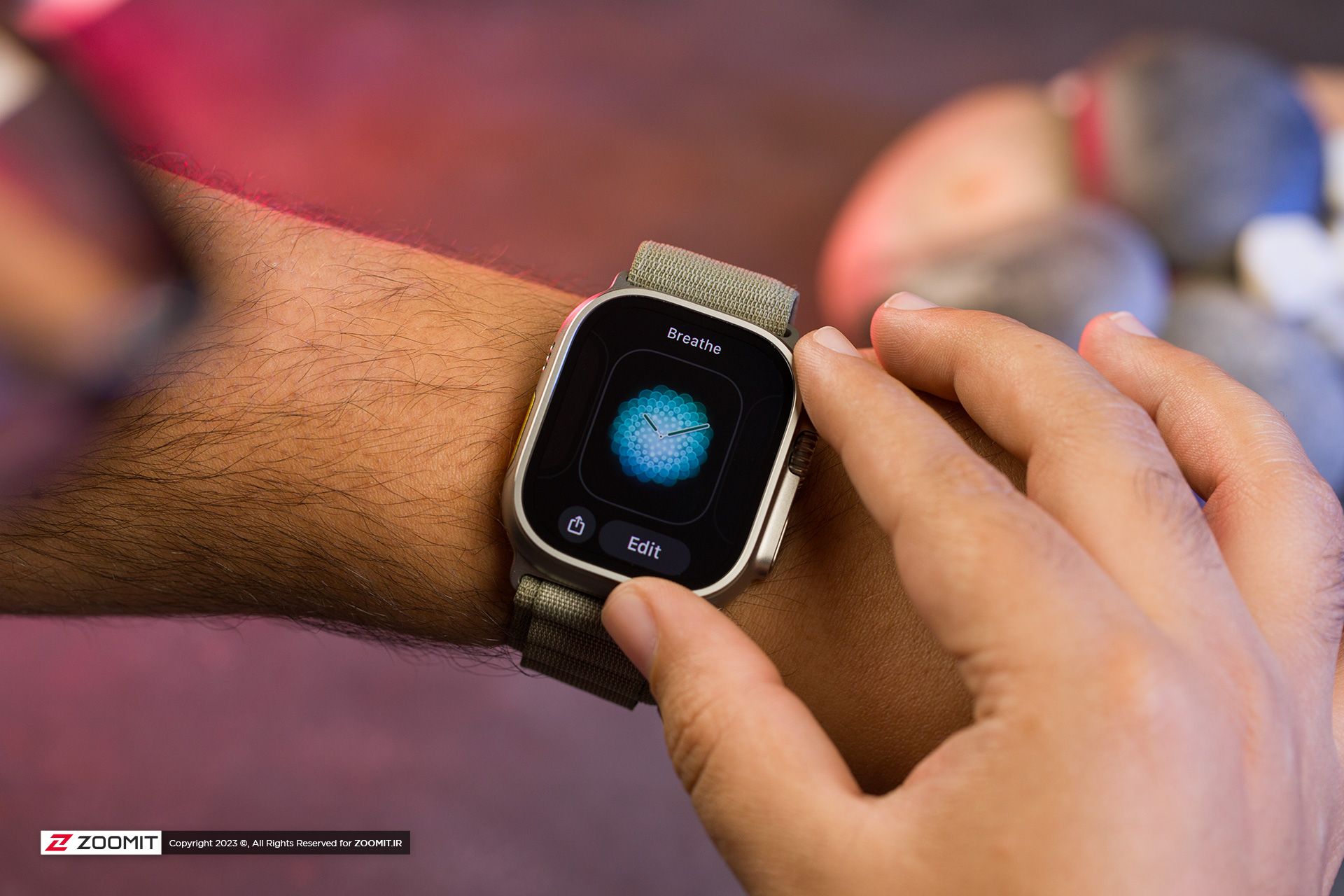
The design of the Apple Watch Ultra 3 will remain intact. Mark German said some time ago that the third generation of the Apple Watch Ultra will be largely similar to the second generation, and that Apple will focus more on the Apple Watch X this year.
Apple Watch Ultra 3 will not experience significant changes
According to Ming-Chi Kuo, the Apple Watch Ultra 3 will experience almost no hardware changes compared to the previous generation, which means that the blood pressure and sleep apnea detection features will probably be software and will rely on the current sensors.
We expect the third-generation Apple Watch SE to be another new Apple smartwatch. This product, which will be the cheapest Apple watch, will be equipped with a larger screen and will probably be available in 41 mm and 45 mm models.
Mark Garman has previously said that the Apple Watch SE 3 will be equipped with a hard plastic body instead of an aluminum body. This change lowers the production cost of the Apple Watch SE 3 and appeals to those who want to enter Apple’s wearable ecosystem without paying a fortune.
Airpod 4; Apple’s different presence in the Togoshi headphone market
The fourth generation of Togoshi AirPods series headphones will probably be unveiled at the same time as the iPhone 16, and this time, unlike the previous generations, we will see the release of two models with different prices.
Leakers say that both AirPods 4 models will have a new design and their case will use the USB-C port instead of Lightning. The AirPods 4 case may be equipped with a speaker so that it can be easily located through the Find My network.
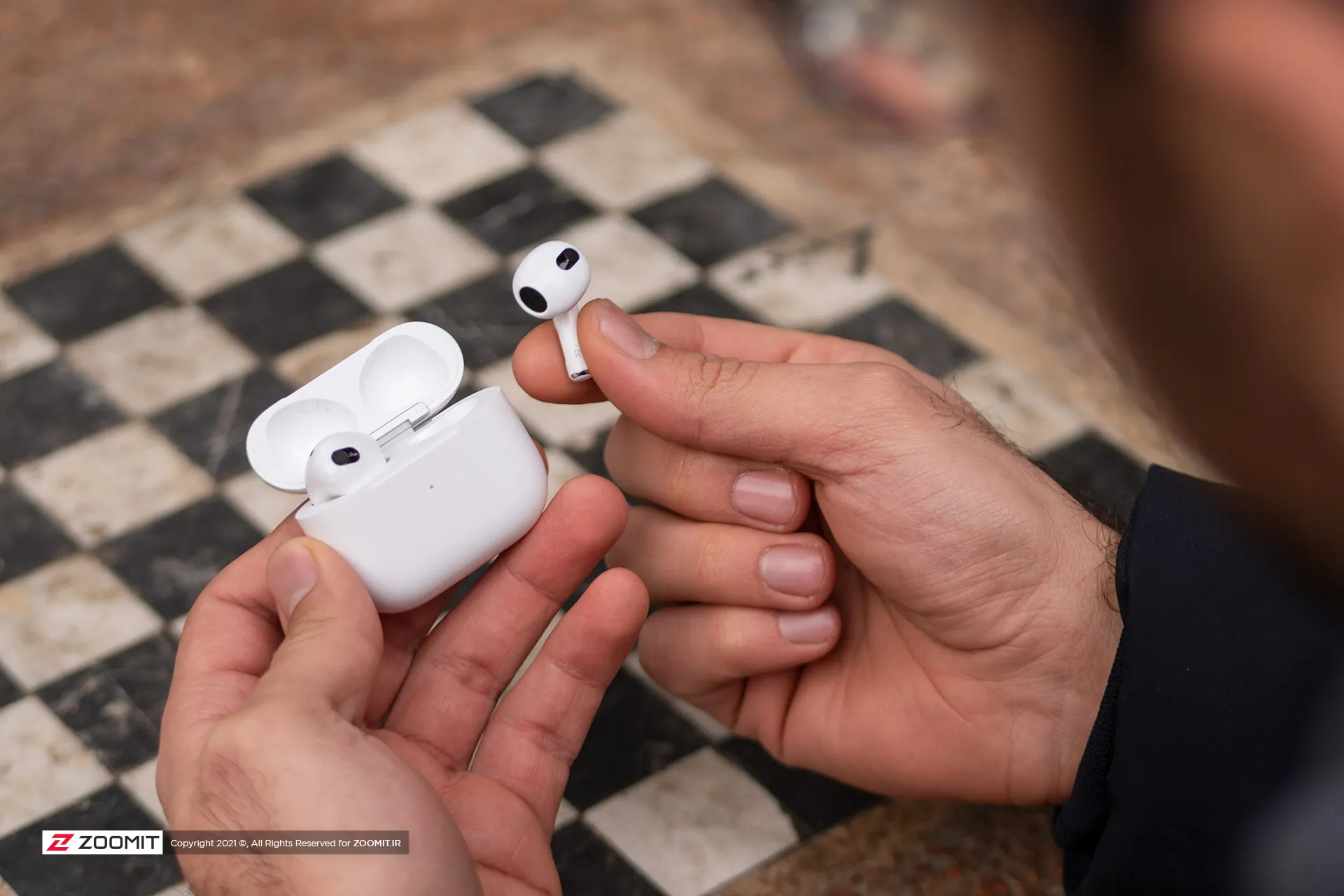
The AirPods 4 will come at a lower price than the AirPods Pro, but unlike the high-end handsfree, it won’t have the same features as the silicon series.
Meanwhile, it is said that AirPods 4 will use the H2 chip like the current generation AirPods Pro. The second and third-generation AirPods use the H1 chip. The H2 chip comes with Bluetooth 5.3 so that AirPods can be connected to different devices in a better way. H2 has lower power consumption to provide better charging performance than the third-generation AirPods 4.
Maybe the new generation of AirPods Max will be shown at the iPhone 16 unveiling ceremony after years; However, such an event seems far from expected. Leakers have said that the AirPods Max 2 will be released in “late 2024”.
AirPods Max is currently the oldest model in Apple’s headphone family and was launched in 2020. The big change for the AirPods Max 2 will be the use of a USB-C port.
Read more: All Apple products that will arrive in the fall of 2024; From iPhone 16 to iMac M4
Possible surprise: iPad mini 7
The iPad mini was last updated in 2021, and the sixth generation of the product is struggling with low inventory at most Apple stores. This issue has started rumors about the unveiling of the new model.
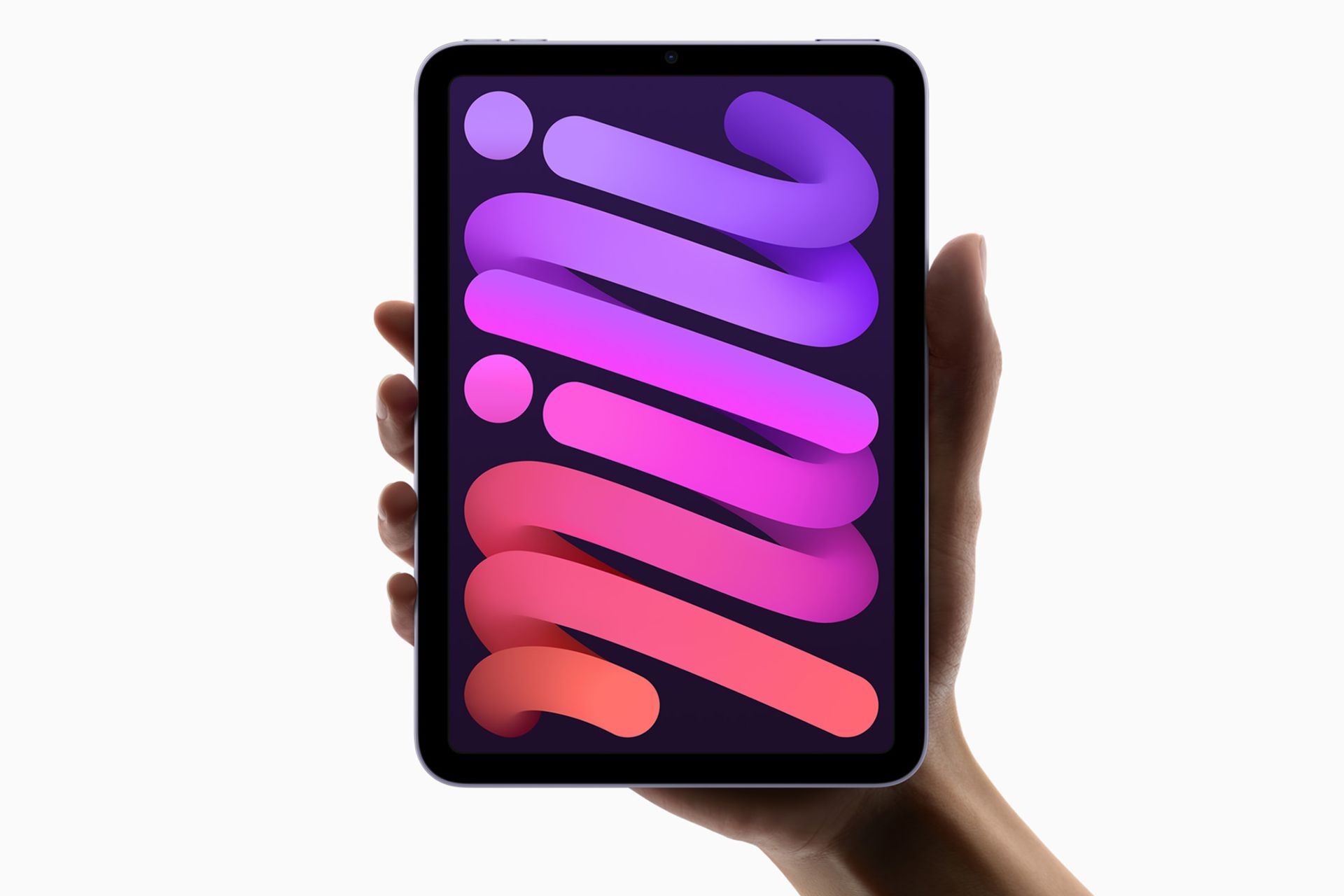
Apple
Mark German says that we are not far away from the iPad mini 7 unveiling, but he has not announced an exact date yet. The iPhone 16 unveiling ceremony will not be the right time to introduce the iPad Mini 7; Because the iPhone 16 and the new generation of Apple Watch are definitely going to attract all the attention.
According to rumors, the iPad mini 7 will use the A17 Pro processor and will have access to Apple’s artificial intelligence. The front and back cameras of the new Apple tablet may host a series of changes.
Other important events; From accessories to artificial intelligence and the new version of iOS

MacRumors
Apple releases a significant variety of accessories for its products every year, and we have no doubt that new cases and bands will be available after this year’s event.
One of the important events of this year is the release of the Apple Watch in new dimensions. To attract people, Apple needs to release a lot of new bands to cover all kinds of tastes.
Apple’s artificial intelligence has been unveiled before, but it still doesn’t have an exact release date. Apple may mention the release date of its own artificial intelligence in the final part of the iPhone 16 unveiling ceremony.
Every year, new versions of Apple’s operating systems are made available shortly after the iPhone’s unveiling ceremony. This will probably happen again this year for iOS 18 iPadOS 18 and macOS Sequoia.
Technology
Google brand story; From a small startup to ruling the web world
Published
2 days agoon
08/09/2024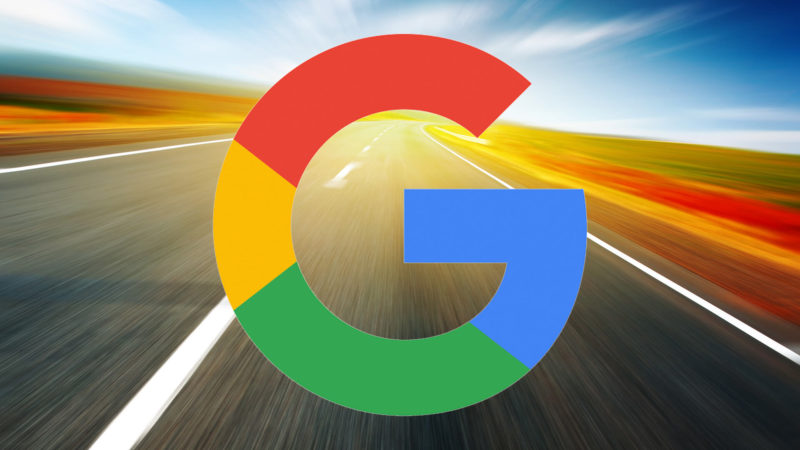

Proper noun: A search engine that popularized the company of the same name.
Preposition: For each; per.
Noun: A topology name.
Adverb: Beyond all others.
Preposition: For each; per.
Noun: A topology name.
Adverb: Beyond all others.
Preposition: For each; per.
Noun: A topology name.
Proper noun: A particular Internet company.
Proper noun: A search engine that popularized the company of the same name.
Proper noun: A particular Internet company.
Proper noun: A search engine that popularized the company of the same name.
Proper noun: A particular Internet company.
Proper noun: A search engine that popularized the company of the same name.
Proper noun: A particular Internet company.
Proper noun: A search engine that popularized the company of the same name.
Proper noun: A particular Internet company.
Proper noun: A search engine that popularized the company of the same name.
Google brand story; From a small startup to ruling the web world
The general public of the world cannot imagine removing Google services from their lives today. Regardless of the search engine or the Chrome browser, most of us set our programs on Google Calendar, and using Gmail, Google Drive, Google Docs, Google Maps, Google Photos, YouTube, and the like has become a daily habit for us.
Google’s role in shaping our relationship with the Internet world is undeniable. Many of this company’s products have known alternatives, But Google has designed its comprehensive and integrated ecosystem in such a way that we cannot easily abandon the use of all its applications and services.
This article was updated on the occasion of the anniversary of the establishment of Google on 14 September 1403.
But how dangerous will it be for technology companies to gain power at this level? Today’s opponents of Google are divided into several groups: some believe that Google is acting against the direction of freedom of expression by prioritizing certain search results. One group also argues that Google collects user data in a variety of ways that people are unaware of and that this data is not necessarily used in advertising.
For example, some activists of the de-Google movement say: “Spying on people at this level is not acceptable and should not be. “We need to control the technologies we interact with, not the other way around.”
But 26 years ago, before it came under the microscope of US antitrust cases and its empire was in danger of being disintegrated, the initial idea for founding the company was formed with a student project with the aim of facilitating people’s access to web information.
Back then, finding specific content on websites was more like exploring a disorganized library. Even the algorithms of the best search engines, such as Xcite and Altavista, often displayed scattered links in response to user queries that may or may not be related to the user’s search. In fact, finding what you were looking for was more like a game of chance. But Google changed everything.
Join us to review the story of the origin of the Google brand and its evolution.
Getting to know the founders of Google and the BackRub project
Larry Page and Sergey Brin met in the summer of 1995 at Stanford University’s doctoral student induction program, which included a tour around San Francisco. Both of them had just finished their master’s degree in computer science and were about to enter the doctoral degree with brilliant academic records.
Sergi Brin, who had a more social spirit, had volunteered to lead one of the student teams during the event. He had to show the university campus to the students and also lead the said recreational tour. Larry Page happened to be his bandmate and, contrary to expectations, their association during the camp was not pleasant for either of them.
According to Larry Page, Sergey Brin was too proud, while Sergey Brin considered Larry Page to be an unbearable person. They talked about urban infrastructure and social order for almost the entire camp and did not agree at any point.
Page later said in an interview: “We were arguing for a long time, Sergi had strong ideas and I think I was the same.” Sergiy Brin also confirmed his words and continued: “Both of us considered the other party hateful!” But the fact that we took time to discuss with each other showed that we also value thoughts.” They clearly complemented each other.
By the start of the first semester of their Ph.D., Page and Breen were no longer in contact and were working on their own projects and research. Page had learned from his father, a computer science professor at Michigan State, that a doctoral dissertation could determine the ultimate path of one’s academic career. When he approached his advisor, Terry Winograd, to decide on a thesis topic, he put more than 10 interesting ideas on his desk.
Larry Page had more than 10 different topics in mind for his thesis
However, Larry Page’s work did not start with researching the web search engine. Although Stanford graduates were getting rich founding Internet companies, Larry Page found the Web primarily interesting for its mathematical properties: each computer was a node, and each link on a Web page established a connection between nodes, something that a structure It showed classic graphics.
He says:
Computer scientists love graphs, and the World Wide Web could be the largest graph ever created.
Finally, with the consent of his mentor, Terry Winograd, Page began to examine the structure of web links. The point that disturbed his mind in the first stages of research was that although surfing the web from one page to another by following links was a simple and trivial task, few people paid attention to the reverse process, that is, the number of links behind each web page.
Larry Page in the BackRub project was looking for a way to count and determine the importance of each backlink on the web
Page thought that knowing which pages were linking to which pages would have many potential uses. This research led him to BackRub, a project focused on backlinks: perhaps if he could find a way to count and determine the importance of each backlink on the web, the web would become a more valuable place.
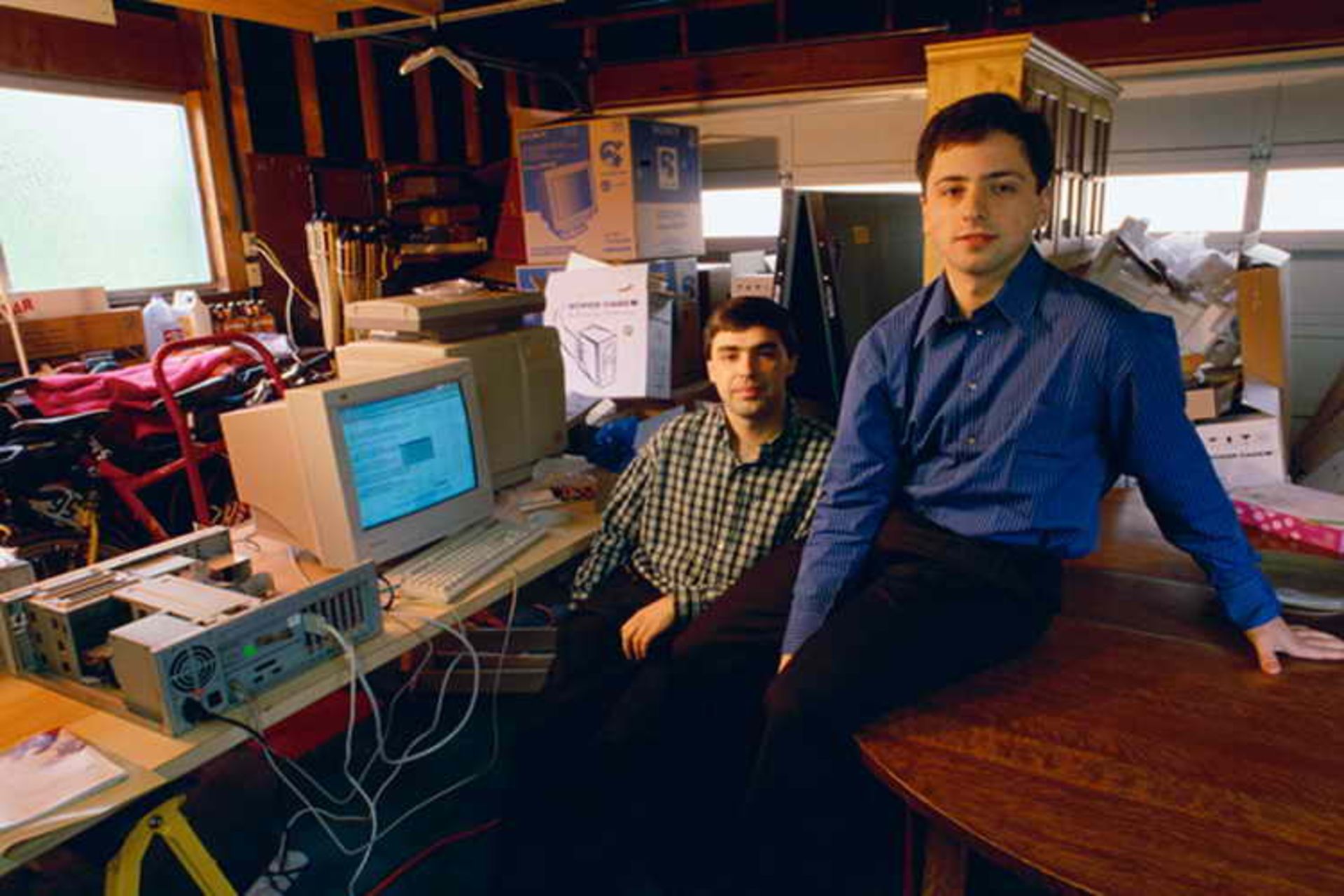
At that time, the web contained about 10 million documents with countless links between them. The computing resources of such a project were estimated far beyond student theses, and the dimensions and complexity of the project attracted the attention of Sergey Brin, who had worked on data mining articles and algorithm analysis during his PhD.
Sergey Brin joined the BackRub project and took over the mathematical side of the research, while Larry Page worked on link weighting and backlinks.
The weight of the links, in simple words, indicated that each link is from which source and with what degree of importance it targets another website. For example, the importance of the link that Intel’s website gave to IBM’s website was very different from the link that a teenager’s diary-blog gave to IBM’s website.
Sergey Brin handled the mathematical part of the research and Larry Page focused on link weighting
On the other hand, each link was placed in a different position and ranked according to the number of links on its home page. In other words, they counted not only the number of links on a page but also the links that were attached to each particular link. As the project progressed, its mathematical dimensions became more surprising and complex.
Sergey Brin says:
I loved data mining, which means analyzing huge amounts of data and finding patterns and trends. At the same time, Larry wanted to download the entire Internet, which contained the most interesting data possible for analysis.
Based on the results of their research, Page and Brin designed an algorithm called PageRank, which sent more popular sites to the top of the list and less important sites to the bottom of the list.
While investigating the work, they realized that the outputs of this model act somewhat similar to the search engine. In fact, BackRab was already a search engine that took a URL and provided a list of backlinks ranked by importance.
In addition, BackRub’s results outperformed those of other existing search engines such as AltaVista and Excite, which often listed irrelevant sites. By focusing on keywords, these search engines only looked at the text of the websites and ignored the most important factor, the ranking of the web pages.
Page and Brin developed the first search tool experimentally. This software only considered the headlines and page titles of the websites and then used the PageRank algorithm to rank and sort the websites. The results were significantly better than popular search engines.
Search engine development
At this point, Sergey Brin and Larry Page realized that they had taken a big step: the backrub engine not only performed well but also scaled as the Internet expanded. In other words, since the algorithm worked by analyzing links, the bigger the web, the more powerful the search engine.

For this reason, Page and Brin chose the name Googol (meaning the number one and 100 zeros in front of it) for their search engine, which was a symbol of processing the endless amount of information on the web. They published the first version of Google in August 1996 on the Stanford website with the domain google.stanford.edu, a year after they first met and got to know each other.
Page and Brin released the first version of Google for Stanford students with the domain google.stanford.edu
Its initial version was a success among a small group of Stanford users, and the two classmates quickly began improving the service to monitor the entire content of websites in addition to titles, while indexing more pages.
After Page’s room was filled, Brain’s room became their programming center and management office. Before long, the former BackRab was a legendary project in Stanford’s computer science department, consuming nearly half of the university’s network bandwidth. By the fall of 1996, it had gotten to the point where the search engine was regularly disconnecting Stanford’s Internet connection.
Larry Page later recalled:
We were lucky that there were so many forward-thinking people at Stanford who didn’t blame us too much for the resources we used.
The founding of Google: A Star rises
Page and Brin registered the google.com domain in September 1997. They knew that they could no longer rely on university resources to continue. In August 1998, one of the university advisors suggested that they meet Andy Bechtolsheim, the founder of Sun Microsystems. The meeting was held on the porch of this consultant’s house with a demonstration of the Google search engine.
Andy Bechtolsheim wrote a check for $100,000 to Google Inc. But the problem was that there was no company called Google yet. Page and Breen kept the check in their dorm room for several weeks while they went through the business registration process and opened new bank accounts for their business.
 Andy Bechtolsheim, Google’s first investor
Andy Bechtolsheim, Google’s first investor
Google was officially registered on September 4, 1998, and according to the previous agreement, Larry Page became the CEO and Sergey Brin became the company’s president. The two defined the company’s mission in one phrase: “Organizing the world’s information and making it accessible and useful to all people.”
Google’s mission: “Organizing the world’s information and making it accessible and useful for everyone.”
Page and Breen moved their tools and equipment to the company’s first office, which was the garage of their friend Susan Wojitsky’s house in Menlo Park, and by the end of the year, they had hired six more software engineers to work with them. By the end of 1999, the number of Google employees reached 21 people, among whom the names of Salar Kamangar, Omid Kurdestani, Suzan Vejitsky, and Marisa Mir stand out.
While Google’s daily searches were growing exponentially, the development of the company’s infrastructure required more capital.
 Google’s first office in the garage of Suzanne Wojitsky’s house
Google’s first office in the garage of Suzanne Wojitsky’s house
At the end of the first year of its establishment, it held its first fundraising round and received a total of one million dollars from three angel investors, Amazon CEO Jeff Bezos, Stanford University computer science professor David Cheriton, and Ram Shriram, one of the entrepreneurs of the technology world.
Andy Bechtolsheim, the founder of Sun Microsystems, was Google’s first investor
Many investors thought that the idea of a search engine startup would go nowhere, because the effort of technology companies was to keep users on their websites longer, and the search engine made people go from one website to another.
 Google page in 1998
Google page in 1998
But the potential and early success of Google in the second round of fundraising attracted the attention of two famous venture capitalists: John Doerr of Kleiner Perkins and Michael Moritz of Sequoia Capital, after carefully examining Google, they decided to invest a total of $50 million in this fledgling startup. .
The interesting point is that before these investments, Larry Page and Sergey Brin had offered Excite to buy their startup for one million dollars, but Excite refused to pay more than 750,000 for Google, and thus the contract was canceled.
 Google team in 1999 Palo Alto office
Google team in 1999 Palo Alto office
After raising capital, Google moved to its second office in Palo Alto, home to many famous Silicon Valley startups. In 2000, the Google team launched Google AdWords with the idea of Susan Wojitsky, which optimally changed the company’s revenue stream.
The AdWords service allowed companies to show their ads precisely to those who were looking for related products or services. This service was a revolutionary example in the world of online advertising and allowed Google to have a powerful money-making machine in addition to the search engine.
While the number of Google searches increased daily, with these changes, Google employees found a better mood and focused strongly on the path of progress.
At this time, John Doerr and Michael Koritz, the main investors of the company, according to their long-term experiences in the technology world, suggested to the founders of Google to hire a more experienced manager to lead their startup. Sergey Brin and Larry Page conducted complex interview sessions with several candidates but found none of them aligned with Google’s vision and long-term horizon.
In 2001, Eric Schmidt went to the interview meeting of the founders of Google with his hands full: he had detailed plans for developing Google internationally, diversifying products, sales, and accounting strategies, and managed to get on the Google board. A few months later, Page and Brin tapped him to become Google’s CEO, seeing Schmidt as the best fit for the company’s IPO event.
CEO Eric Schmidt’s tenure: Google’s explosive growth

Eric Schmidt was appointed CEO of Google in August 2001 and remained in this position for 10 years. The joint idea of Sergey Brin, Larry Page, and Eric Schmidt was to create a comprehensive ecosystem that would meet all the digital needs of users through Google.
In the product development department, Schmidt had Merissa Meyer by his side, who had previously managed web products with user interface changes and the introduction of Google Doodles. One of the first developments of Google in the search engine side was the addition of the image search section.
In 2002, Yahoo planned to buy Google for $3 billion
In 2002, Yahoo tried to buy Google for $3 billion, but Page and Brin rejected the offer; Because they believed that their startup has more value.
Google executives wanted this company to be a symbol of the endless power of innovation; For this reason, they adopted a policy that allowed Google employees to dedicate 20% of their working time to projects that interest them, even if it is outside the scope of their official duties. This policy led to the emergence of some of Google’s most popular products in the following years.
In 2003, the Google News division was launched, and the board of directors purchased a building complex in Mountain View, California, to provide a suitable space for the company’s operations until they employed a thousand employees.
 Google Camp in Mountain View
Google Camp in Mountain View
This office, known today as “Google Plex”, expanded over time by purchasing the surrounding buildings and became the largest company camp in the world.
From Gmail to Chrome: The products that changed the web market forever
In 2004, the Gmail service created a storm in the world and raised the company’s position among users to a new level.
With 1 gigabyte of storage space, Gmail allowed users to quickly search for any email they had sent or received. In addition, this service provided users with new ways to automatically organize emails by topic. Many people thought that Gmail was Google’s April fool, but luckily it was not.
Gmail’s features far exceeded other free email services
In this era, Google’s revenue-generating strategies worked well, so that a few days before the initial offering of Google shares, stock market experts considered the company’s future to be very profitable.
 Gmail in 2004
Gmail in 2004
Finally, on August 19, 2004, Google’s IPO event took place at a price of $85 per share, bringing a fortune of about $1.7 billion to the company’s founders and early investors. In addition, the value of the company was estimated at 27 billion dollars.
 Google IPO on Nasdaq with Eric Schmidt and Larry Page
Google IPO on Nasdaq with Eric Schmidt and Larry Page
The introduction of the Google Maps service in 2005 marked another success in Google’s career and became a background for the company’s research collaboration with NASA. Google Maps evolved over time and became one of the most valuable features of Google to facilitate people’s daily lives.
Google started working with NASA after the introduction of Google Maps
But no one expected the company’s next revolutionary product to impact the entire tech world.
In September 2008, Google introduced the Chrome browser to the world. Interestingly, Eric Schmidt was against Google’s entry into the web browser market from the beginning, and this product was developed at the insistence of Sundar Pichai, one of the company’s forward-looking executives who was supposed to play a key role in the company’s future.
To create Chrome, Google hired some of the original Firefox engineers and developed the browser first for Windows and then for other operating systems. The first version of Chrome came with a 40-page visual guide to show users how to work with the browser. In just 4 years, the popularity of Google’s browser surpassed Firefox and Internet Explorer.
Schmidt later said in an interview:
I told Larry Page and Sergey Brin that we shouldn’t think about browser or operating system development, we shouldn’t compete with Microsoft. They told me they were hiring people to improve Firefox, and six months later they showed me Chrome. To be honest, I was so excited to see the Chrome demo that I had no choice but to admit I was wrong.
At the same time, Google’s organizational culture was still at the center of attention. This company was known as one of the best working environments in the world by maintaining a creative work environment. In such an environment that was based on the freedom of creativity and innovation, Google could attract the best talents and encourage them to create new and efficient products.
Strategic purchases: Doubleclick, YouTube and Android
At a time when Google was improving the level of user experience by offering various products that often had better performance than competitors, it was also preparing the ground for building an inclusive ecosystem by buying leading startups.
For example, the company took the biggest step toward expanding its pervasive advertising empire across the Internet with its $3.1 billion purchase of DoubleClick, the company’s most expensive acquisition at the time. In 2006, Google also bought YouTube for 1.65 billion dollars to give its plans in the field of video content a more serious color.
Under the leadership of Salar Kamangar and then Susan Wojitsky, YouTube became one of Google’s most valuable assets and one of the best online video content platforms, used by millions of users every day.
One of the other decisive actions of Google is the purchase of the Android operating system for 50 million dollars in 2005, which was released in 2008 for the T-Mobile G1 phone known as the HTC Dream. Open source software and integration with the Google ecosystem and the highest levels of notification capabilities were the most important features of Android that made it the most popular mobile operating system in the world.
So far, there has been no news of Google’s serious presence in the smartphone market.
Founding of Alphabet and CEO Larry Page: Reorganizing the company
Between 2010 and 2014, Google was trying to create a new chapter in its history. Delving into fields beyond the search engine and web browser, the company had become a global innovation laboratory pursuing ideas ranging from driverless cars to projects in healthcare, renewable energy, and artificial intelligence.
In April 2011, Eric Schmidt resigned, saying that Google no longer needed the supervision of veteran executives like him, and Larry Page took his place. Larry Page and Sergey Brin realized a long time ago that they needed structural changes to better manage a company as big as Google and focus more on their ambitious projects. For this reason, in 2015, they made a bold decision.
They established a new holding company called Alphabet and brought Google and their other projects and companies under its umbrella. This move was not only a structural rearrangement but also reflected a profound philosophical change in Page and Breen’s approach. In this way, Google found a different position and at the same time in sync with a set of independent companies, each of which was looking for its specific and sometimes ambitious goals.
For example, the Google X division managed modern projects such as self-driving cars and smart cities. Meanwhile, Calico oversaw research related to increasing human lifespan and improving quality of life, and Verily focused on medical and biotechnology research.
In May 2011, Google reached a record of one billion visitors
Larry Page remained the CEO of Google until 2015, after which he took over the management of Alphabet. During his CEO tenure, Google experienced many ups and downs.
In May 2011, Google reached a record of one billion unique visitors. In the same year, “Chrome OS” was also introduced, which was mainly used in Chromebook laptops. These laptops were manufactured by Acer and Samsung and were first released to the general public in some retail stores, but in later years were made available to students and teachers in schools for educational purposes.
 Google+ circles page
Google+ circles page
This period coincided with the introduction of one of Google’s famous and failed projects, namely Google Plus. The fact was that Google managers wanted to compete with Facebook by launching a social network, and in this regard, they replaced Google Plus with the Google Buzz microblogging service. Despite repeated redesigns, Google Plus never achieved success.
Google wanted to compete with Facebook by launching Google Plus
Another unfinished project of the company was Google Glass, whose experimental hardware was developed in the Google X and ATAP divisions. Despite the good idea and design, Google Glass needed technologies to process information that had not yet been developed at that time. In addition, some companies considered this product to be against their privacy and banned employees from using Google Glass.
July 2013, when Google announced the end of the Google Reader service, fans of this popular feed reader looked at this decision in disbelief. Shutting down Google Reader required courage, as we later saw in removing the headphone jack from iPhones. But this action made many Google users move to Twitter and search for daily news in tweets.
Finally, the purchase of DeepMind, an artificial intelligence laboratory based in London, was one of the most important steps taken by Google in this era, which later played a significant role in gaining the power of Google’s artificial intelligence department.
CEO Sundar Pichai’s era: the season of fighting with rivals
In 2015, together with the founding of Alphabet, Sundar Pichai, the company’s senior vice president under Eric Schmidt, replaced Larry Page as Google’s new CEO. Pichai, who joined Google in 2004, had proven his ability in leading the Google search bar, Google Gears, Google Pack, and Google Drive projects.
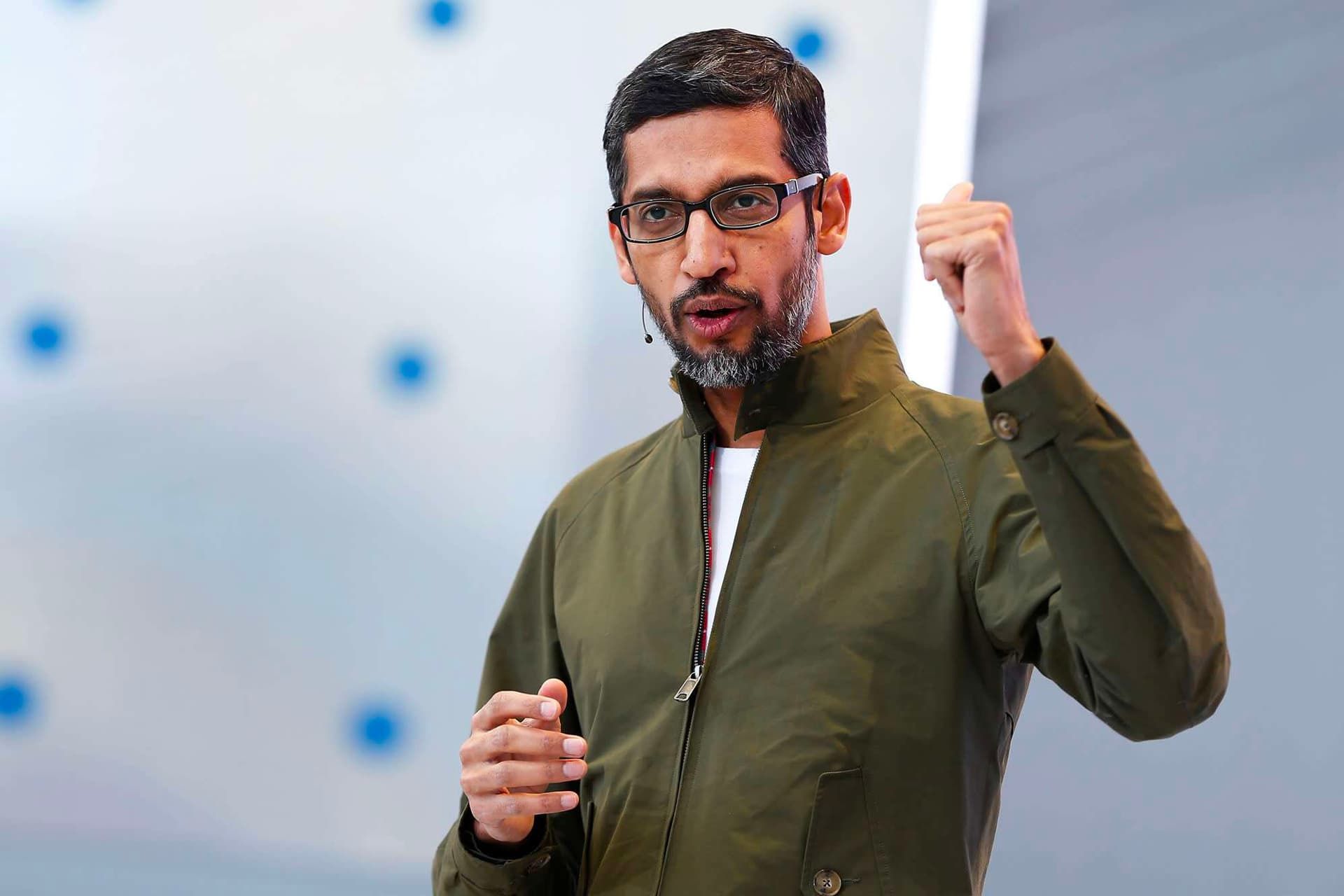
Pichai soon became one of the well-known faces of Google due to the idea of the Chrome browser and the management of the team that was responsible for the development of this software, and he became the deputy CEO of the company. He also played a significant role in the development of Android and the development of Google Apps.
One of the most important products that was introduced in the early days of Pichai’s CEO was Google Assistant. Google Assistant was introduced two years later than Amazon’s Alexa and 5 years after Apple’s Siri, But very soon it found its right place among users.
The wish of the founders of Google for the development of an inclusive and integrated ecosystem was realized during the management of Sundar Pichai
The strength of this virtual assistant was its synchronization with other products of the Google ecosystem, such as Google Home speakers, smart TVs, and most importantly, Android systems. Also, in 2016, Google announced the production of tensor processing units.
In October 2016, Google was at the forefront of the competition of flagship phones in the hardware sector with the introduction of Pixel phones, and two months later, the self-driving car project, which was considered one of the most successful projects of the Google X laboratory, was transferred to Waymo as an independent company after 6 years of testing. Guide the alphabet.
Sundar Pichai, unlike Eric Schmidt, was not afraid of competing with powerful technology companies, although now Google had also found a different face and no one considered it a new Silicon Valley player.
For example, Sundar Pichai had a special focus on the company’s cloud services, and despite long-standing competitors in this field such as Amazon and Microsoft, he invested heavily in building new data centers and developing cloud networks. With his efforts, Google Cloud became one of the top three cloud service providers in the world.
By introducing artificial intelligence tools and platforms in its cloud platform, Google was able to support corporate customers in various fields, including data analysis, machine learning, and process automation. During this period, the development and expansion of Nest smart home products also reached its peak. Although Google bought Nest in 2014, in recent years the integration of these products with the Google ecosystem has provided customers with an unparalleled user experience.
Some Google products, such as Google Translate, Google Lens, and Google Mate, found an undeniable role in people’s daily lives, and some projects, such as Google DeepMind projects, with every development and news, surprise the world beyond the technology world. Also, under the effective leadership of Sundar Pichai, Google has become one of the most powerful companies in the highly competitive market of generative artificial intelligence.
Google’s presence in the mobile market: from Nexus to Pixel
In the early 2010s, Google executives decided that they needed to enter the mobile market to improve the Android user experience and ensure timely updates for users.
At that time, Android was available as an open-source operating system to different manufacturers, and each company released its own version with desired changes and different user interfaces. But by producing Nexus phones, Google intended to provide users with a pure and integrated Android experience.

The first Nexus phone, named Nexus One, was introduced in January 2010 in collaboration with HTC. After that, Google introduced new Nexus models every year in partnership with one of the smartphone manufacturing companies:
- Nexus S: Samsung manufacturer, Android 2.1 Eclair operating system can be updated to Android 2.2 Froyo and Android 2.3 Gingerbread
- Galaxy Nexus: manufactured by Samsung, the operating system Android 4.0 Ice Cream Sandwich can be updated to Android 4.1 Jelly Bean
- Nexus 4: manufactured by LG, the Android 4.2 Jelly Bean operating system can be updated to Android 5.1
- Nexus 5: manufactured by LG, the Android 4.4 KitKat operating system can be updated to Android 6.0.1 Marshmallow
- Nexus 6: Motorola manufacturing company, Android 5 operating system before update to Android 7.1.1 Nougat
- Nexus 5X: manufactured by LG, operating system Android 6.0 Marshmallow updatable to Android 8.1.0 Oreo
- Nexus 6P: Huawei manufacturer, Android 6.0 Marshmallow operating system
The production of Nexus phones continued until 2015, but Google gradually realized that this series of phones, despite the loyal fans, could not compete well with other flagships in the market.

The production of the first series of Pixel phones began in 2016, and Google played the main role in the design and development of this series. The company optimized pure Android for Pixel phones to provide a smoother experience to the audience.
Since Google’s main goal was to compete with the flagships of Google and Samsung, it used better hardware and especially improved cameras in these products, which consequently raised their prices higher than the Nexus series. Also, the peak of Android integration with Google platforms was also seen in these phones.
However, since 2019, Google has tried to gain popularity among mid-range phone users by adding the Pixel series to its product series. Also, in 2023, the first Pixel Fold was introduced to compete with foldable phones of competing brands.
Google and artificial intelligence
Google was aware of the power of algorithms and machine learning from the beginning of its activities, and one of the most important areas in which it continuously invested was artificial intelligence.
As we said, in 2014, Google bought DeepMind Lab, which had advanced research in the field of artificial intelligence. Among the achievements of this laboratory, we can mention Alphago and AlphaFold projects.
 Demis Hessabis, co-founder of Deepmind
Demis Hessabis, co-founder of Deepmind
Researchers at the AlphaGo project developed neural network models specifically for video games and game boards, and in 2016 AlphaGo beat the world champion Go player in a competition. Alphafold also made a significant contribution to the pharmaceutical industry by accurately predicting the three-dimensional structure of proteins using a deep learning system.
On the other hand, Google had opened a special account on the development of neural processing units. TPUs, or tensor processing units, were custom-designed silicon chips developed specifically for machine learning and optimized for TensorFlow. According to Google, TPUs train and run AI models much faster than traditional chips.
In 2019, Google used Bert algorithms in its search engine, which understood the meaning of words in the text instead of understanding words separately. According to Google, Bert greatly improved the responsiveness of the search engine, because users could ask Google their questions naturally instead of listing their desired keywords.

In 2023, Google finally made Bard’s generative artificial intelligence system available to users, which was based on the large conversational language model LaMDA. Google Bard was integrated into many everyday Google services such as Drive, Maps, Docs, Gmail, and YouTube.
With the increasing popularity of ChatGPT, in May 2023, Google introduced the next generation of its artificial intelligence language model called PaLM 2, which had more capabilities in the field of understanding different languages and the power of reasoning and coding. Google Jumnai based on this model was developed and replaced Bard.

Getty Images
Google’s noticeable speed and effort in the field of productive artificial intelligence can be considered one of the most obvious competitive manifestations of this company to obtain a greater share of various technology markets. After Microsoft’s huge investment in the startup OpenAI, Google also invested 500 million dollars in the startup Entropic.
The challenges of Google Jamnai photo production caused Sundar Pichai to invite Sergey Brin and Larry Page to have a closer relationship with this company by declaring an emergency (code red). Following this event, Sergey Brin officially confirmed his return to Google.
Also, in 2024, Google showed its readiness to compete with Apple by completely redesigning Android and took great steps towards local processing of artificial intelligence features in phones, such as Circle to Search.
Google Antitrust Cases: Growing Challenges
The flow of legal cases and complaints related to Google’s monopoly started in 2010; That is when the European Union Commission started a wide-ranging investigation into the anti-competitive behavior of this company. At that time, one of the main accusations was that Google placed its products and services above competitors in the search results, thereby marginalizing other companies.
This investigation became one of the longest and most complex antitrust cases in the history of technology, and finally, in 2017, the European Union sentenced Google to pay a heavy fine of 2.4 billion euros for prioritizing its shopping services (Google Shopping). .
A year later, the European Union condemned Google to pay a fine of 4.34 billion euros; But this time because of the Android operating system. Now Google was accused of encouraging mobile phone manufacturers to install their own apps (such as Google Maps, Gmail, and Play Store) and thus keeping competitors out of the market.
Read more: Amazon brand story; A store for everything
In this case, Microsoft, Nokia, and Oracle were influential in the final verdict and condemnation of Google by participating in the research group called FairSearch. In 2019, Google was fined another 1.5 billion euros by the European Commission. Google Adsense service was the main focus of these accusations.
 Judge Amit Mehta in the Google monopoly case
Judge Amit Mehta in the Google monopoly case
After this case, it was the turn of the US Department of Justice to file a new and detailed complaint regarding Google’s monopolistic actions in the search engine and advertising market. In this lawsuit, more than 30 US states were on the opposite side of Google and sided with the judiciary.
In response to the accusations of the United States Department of Justice, Google announced that the online search and advertising market is a competitive market and different companies operate in this market. According to Google, users choose the company’s products and services because of their high quality, and this does not indicate exclusivity.
But in August 2024, Google finally lost its biggest antitrust case and was convicted by a Colombian court that it illegally monopolized the search market.
The Department of Justice and US prosecutors say that Google pays billions of dollars annually to mobile phone manufacturers such as Apple and Samsung to install the company’s search engine as the default application on their products in order to maintain its 95% share of mobile searches.
The consequences of this ruling can be very heavy for Google, while Google still has several other antitrust cases pending.
On the eve of the 26th year of Google’s establishment, this company with a market value of 2.02 trillion dollars is known as the fourth most valuable company in the world.
However, Google has never faced such serious challenges. Will it break up as US government and judicial officials say? Will the emergence of new artificial intelligence search systems such as SearchGPT diminish the popularity of Google’s search engine? How do you see the future of it?


How to hide a file or directory in Linux?


Everything we expect from the iPhone 16 unveiling ceremony


How does loneliness affect the brain and body?


Why is the loneliness epidemic so hard to cure?


Google brand story; From a small startup to ruling the web world


5 exciting features of Windows 11 2024 update


What is a nebula? Everything you need to know about it


Canopus; What do we know about the second brightest star in the sky?


Can humans endure the psychological torment of living on Mars?


How to use iMessage on Android?
Popular
-



 Technology1 year ago
Technology1 year agoWho has checked our Whatsapp profile viewed my Whatsapp August 2023
-



 Technology1 year ago
Technology1 year agoSecond WhatsApp , how to install and download dual WhatsApp August 2023
-



 Technology1 year ago
Technology1 year agoHow to use ChatGPT on Android and iOS
-



 AI2 years ago
AI2 years agoUber replaces human drivers with robots
-



 Technology1 year ago
Technology1 year agoThe best Android tablets 2023, buying guide
-



 Technology1 year ago
Technology1 year agoThe best photography cameras 2023, buying guide and price
-



 Humans2 years ago
Humans2 years agoCell Rover analyzes the inside of cells without destroying them
-



 Technology1 year ago
Technology1 year agoHow to prevent automatic download of applications on Samsung phones
